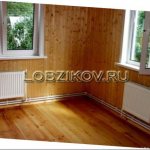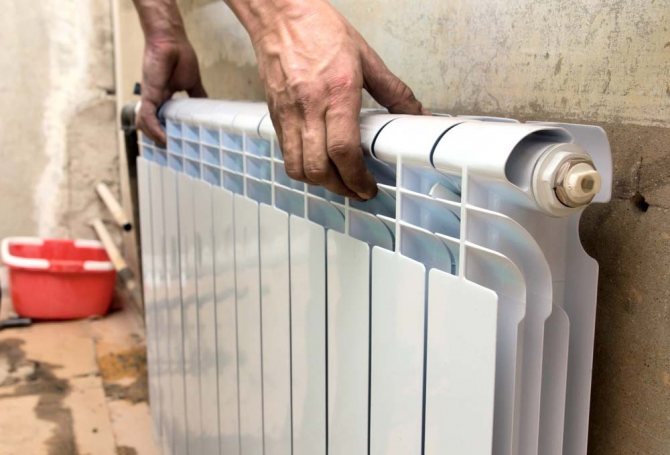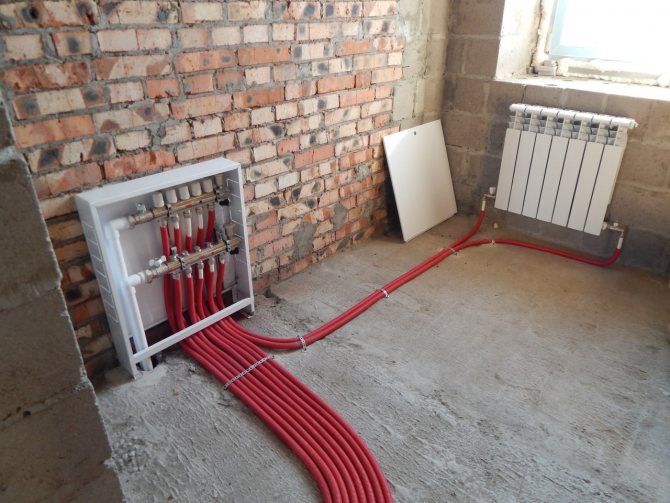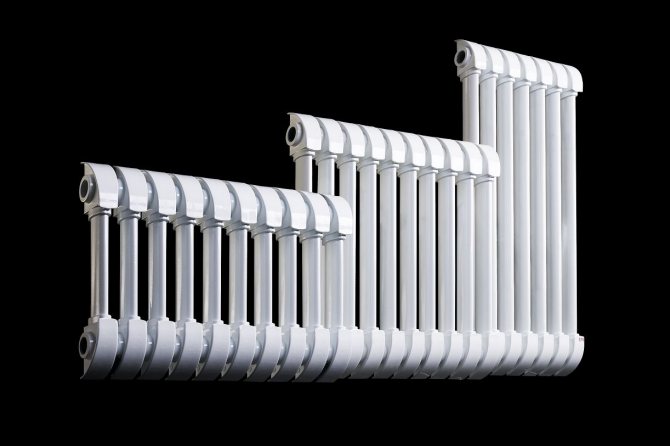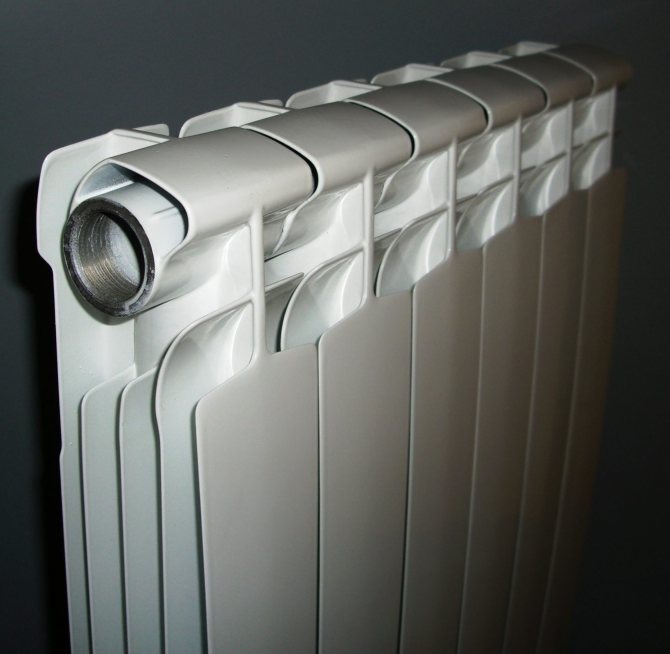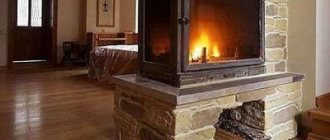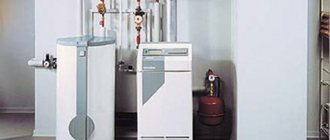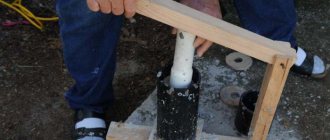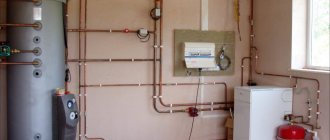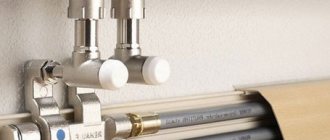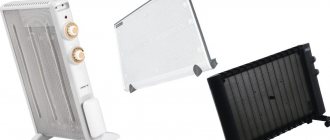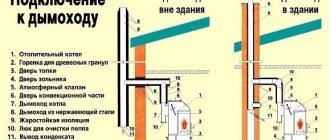If a construction project is just being developed, then it is easier to choose a suitable option for heating a house. Of course, you need to take into account the region, the availability of the most affordable fuel, the number of storeys of the house, the degree of insulation and some other factors that are specified after the thermal calculations. But choosing heating options for a private house of an existing one is a little more difficult. In this case, we are often talking about replacing outdated, or unprofitable heating with another type of heating. In this case, the following types of heating systems for a private house and their popular options are possible:
- water heating using boilers on various fuels;
- gas or electric convectors;
- air heating;
- pipe heating without radiators.
Air heating used for heating is designed and installed during the construction of a house. The option is very expensive, and it is difficult to assemble it for existing premises. We will not delve into the consideration of expensive exotic systems and consider the available and popular types of heating for private homes.
Popular heating schemes
In the presence of a gas main, the gas heating scheme of a private house is the most optimal. In this scheme, a gas boiler is installed as a heat generator, which heats the coolant. The movement of the coolant occurs either under the action of gravity (gravity systems) or with the help of a circulation pump. For small private houses, heating schemes for a private house with a wall-mounted boiler are successfully used, if there is no separate room for a boiler room, and the dimensions of the kitchen are limited.
The piping layouts themselves are standard:
- one-pipe;
- two-pipe.
One-pipe scheme
A one-pipe system with a series connection of radiators is used only in small houses or summer cottages. This wiring diagram has a significant drawback - uneven heating of the batteries, which is especially felt if a heating circuit of a private house without a pump is installed, which is called "gravity". If the length of the circuit is small, then the circulation pump almost completely compensates for this disadvantage. With a large number of batteries and a significant length of the circuit, an upgraded one-pipe system - "Leningradka" is used. It was invented in Leningrad - present-day St. Petersburg.
Two-pipe scheme
The two-pipe scheme for connecting a gas boiler in a private house is the most optimal in terms of uniformity of heating even when using a "gravity system", but more material-intensive. In this scheme, the coolant enters the batteries through the supply pipe, and returns through another, which is called the "return". All heating devices are connected to these two pipes in parallel, which makes it easier to repair and adjust the temperature in different rooms.
House heating installation
Heating a house with a radiator can be done with your own hands, but this is a rather complicated, time-consuming process to complete it yourself.
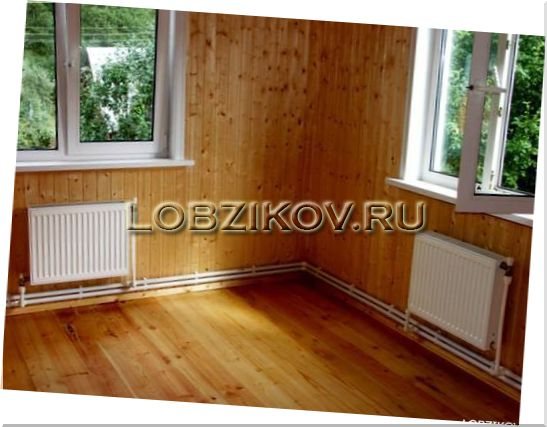
- To install a home heating or install a system, you need to buy torque wrenches of the right size. Since the liquid in the system is under pressure, improper sealing of the connections can lead to the appearance of jets from the pipes and even from the radiator itself.
- Before replacing the battery, it is imperative to shut off the water in the system.
- With the help of a pump, you need to pump out the maximum amount of water, then turn off the water also at the battery being replaced.
- First, you need to prepare a wiring diagram and select all the parts necessary for installation. Their number and type is determined by the circuit, as well as the specific model of the battery used.
With a one-pipe system, a bypass must be foreseen, that is, a bypass path for the flow of the coolant, otherwise, by closing the valve, the heating will become completely paralyzed.
Installation of heating elements
The radiator is installed at a slight slope. If the battery is installed strictly horizontally, then air will accumulate in it over time, and it will definitely have to be manually blown out from time to time. Pipes for the heating system are used metal, metal-plastic or polypropylene.
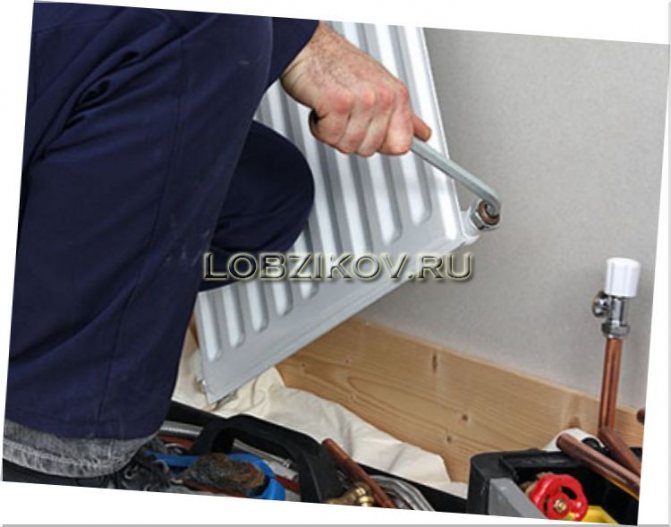

After installation, it is necessary to carry out a pressure test. To do this, you need to call specialists, you can also buy your own pressure operator and do it yourself. Until the crimping is completed, do not remove the packaging film from the radiator.
- Before installing the radiators, it is imperative to unscrew, then tighten the nipples, and then reassemble them.
- It is better to twist the upper and lower nipples with a partner to avoid skewing.
- Then, in the same way, it is necessary to unscrew all sections and start grouping.
- In order to carry out the grouping of the two sections correctly, it is necessary to grab 2-3 threads of thread on both sides with nipples, and then tighten both nipples.
- It is better to use brackets for fastening, but if the walls are made of wood, then they make stands on the floor, only supporting fasteners are made on the wall.
Heating system without radiator
There is, still rarely used due to the high price, pipe heating without radiators in a private house used in the reconstruction or construction of a house. The floor heating pipes are laid in the floors and filled with a screed.
To create a radiator-free system, an integrated manifold is installed, which is integral with the mixing unit.
In such a system, the temperature is automatically regulated and there is the possibility of remote control. There can be several distribution manifolds for each room. For small rooms - bath, toilet, etc., a compact pumping unit is used, for example, Thermotech MINI350 with a built-in 350 W heater. With the help of this device, warm floors are realized in small rooms. Such individual gas heating in a private house is extremely comfortable, but requires significant financial costs.
Which pipes are better
A scheme was chosen, a boiler was purchased and inevitably a decision must be made - which pipes to choose for heating a private house, plastic or metal. Pipes can be made of any material, but either metal or polypropylene reinforced pipes are most often used for heating. Metal and plastic pipes have advantages and disadvantages.
Metal pipes
With the help of metal pipes, all equipment for gas heating of a private house is combined - a boiler, radiators, an expansion tank, etc. Steel pipes are strong, but welding is required for installation. Sometimes owners use threaded connections, but this is a very time consuming method. Metal pipes are susceptible to corrosion and a sediment gradually accumulates inside, consisting of rust and various contaminants.
But they also have undeniable advantages:
- high rigidity, which allows you to install any slope with a minimum of fasteners;
- slight linear expansion;
- resistance to high temperatures, pressure and water hammer;
Reinforced-plastic pipes
Reinforced-plastic pipes are made of polyethylene. They consist of three layers. The middle layer is made of aluminum and all three layers are firmly glued. Aluminum increases rigidity and reduces linear expansion of the pipe. The disadvantage is the high cost.To prevent leaks during operation, you need to use high-quality metal fittings.
Polypropylene pipes
It is recommended to use only reinforced polypropylene pipes for heating. For installation, you need a special welding machine and fittings.
Which radiator is better?
Before you start making heating in the house, you should seriously think about the choice of the material from which the battery will be made. Today there are radiators of four types of material - cast iron, steel, aluminum and bimetal. Each material has both its advantages and disadvantages, which must be taken into account when choosing a boiler and buying it.
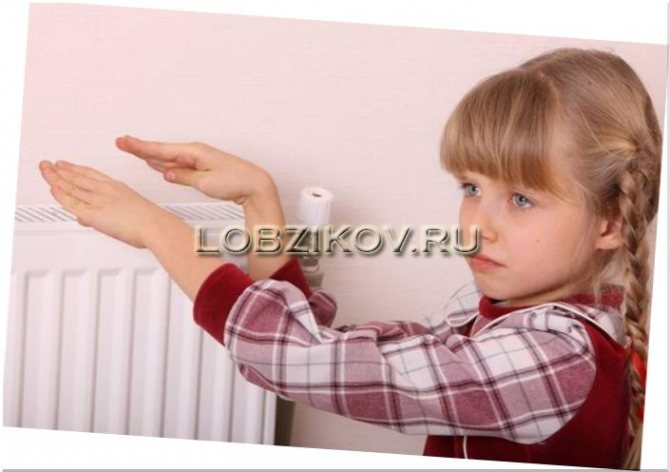

Cast iron
Cast iron. The use of cast iron has been familiar to us since the Soviet years. It was cast iron that was first used for radiators that are used in water heating systems.


For many years this material was the only material from which batteries were made, and it is he who is considered the ancestor of all other models. But today, cast iron heating means are associated with some kind of large and bulky batteries, although in fact modern models of cast iron are absolutely not similar to those that we are used to seeing since Soviet times. They are made in quite original designs.
Aluminum or steel
When buying radiators, many people prefer modern aluminum or steel, excluding cast iron from their choice. But cast iron has many advantages over them. First of all, cast iron batteries are very reliable and the most durable. Today the oldest radiator has been in operation for over 100 years. Let's look at what kind of heating means are still better suited for a private house. Of course, this does not mean that all batteries will last as long, but manufacturers promise 50 years.
- Due to the thick walls of the heating elements, the room will be heated not only by the convection method, but also due to thermal radiation.
- The carbon in the cast iron prevents the iron from oxidizing as much as the steel section oxidizes, which leads to rusting. This is what contributes to the durability of cast iron batteries.
- And the last advantage should be noted the complete immunity of cast iron to any contamination.
In our country, the water used for heating is not entirely clean, and sand, crushed stone, pieces of rust and other small debris are constantly moving along the system along with the water, which significantly impairs the overall operation of the heating system. Contaminated water significantly shortens the lifespan of aluminum and steel batteries by a factor of two or more, despite a ten-year lifespan. And a cast iron radiator in such conditions can work for more than 40 years. Such batteries can operate even in the most unfavorable conditions - at very high levels of internal pressure. Steel batteries, for example, can only work at low or medium pressure levels, and cast iron can easily cope even with a pressure of 6 - 9 atmospheres and a pressure pressure, the level of which can even reach 16 atmospheres. At the same time, it does not affect heat transfer at all. Also, cast iron is completely resistant to water drainage, and this makes them unique for use in conditions where the heat carrier is highly polluted.
disadvantages
But still, despite all their advantages, they have three important disadvantages.
- First, the efficiency level is not the best. Aluminum or steel batteries can be heated to rather high temperatures, when cast iron batteries cannot be saved in high frosts.
- Secondly, the efficiency indicator decreases over time, that is, for 20, 30 and 40 years of service, it gives a completely different temperature.
- And thirdly, they do not have a very beautiful appearance.Although modern models look pretty good, they may not be suitable for every interior.
Steel
These models have little inertia and are also simple in design. Such batteries are a more attractive option for offices or warehouses, as well as shopping and entertainment centers, in which heating is carried out using a heat exchange unit. The heating process with such radiators has some advantage - the temperature rises as quickly as possible, as a result the coolant is not consumed so much. In other words, the battery heats up and cools down quickly enough to provide significant energy savings.
Steel radiators are often made of two plates that are 1.25 millimeters thick. In these plates, recesses are punched out, which form special collectors and connecting channels. Such plates are connected to each other using conventional welding. A large area of such steel panels is able to provide a sufficiently significant level of heat radiation. And the presence of a small ribbing in the interpanel space makes it possible to significantly increase convective heat transfer, and also contributes to an increase in the overall comfort of heating.
The main advantages of steel radiators:
- they are a non-inertial device;
- the lowest cost per kilowatt of heat;
- they are characterized by a fairly high heat transfer.
Disadvantages of steel
The disadvantages include the fact that the service life is not long, compared with cast iron or bimetallic ones. He composes lines up to ten years. Also, these radiators are not recommended to be installed in those houses in which the heating system is central, since this will not make it possible to control the quality of the coolant.
Aluminum radiators
They are fairly lightweight and elegant models that have the highest level of heat transfer. Because of this, they are very popular in the market of our country. Aluminum batteries give off half of the heat only through radiation, and the rest through convection. This feature makes them the best sources of heat in the room. The use of a surface, which is developed in the form of special additional ribs, which are located directly inside in each section, makes it possible to increase the usable heat removal area up to almost 0.5 sq. m. This increases the heat transfer so much that during the operation of the radiator it is better to keep your hand away from it.
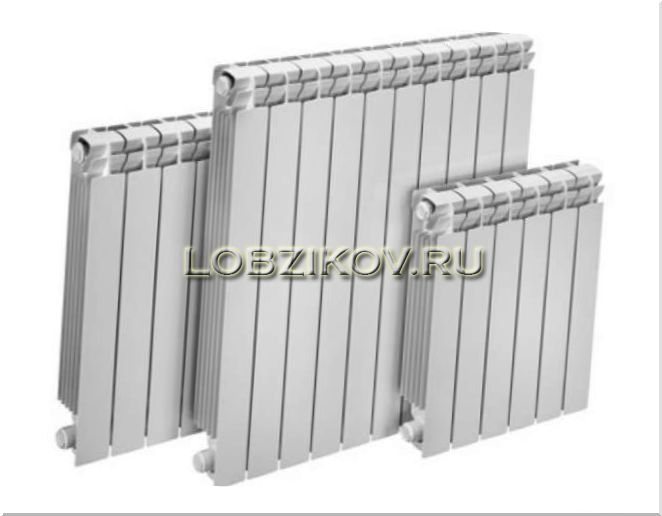

Since not a large amount of water is collected in the sections, they can be easily adjusted using special thermal heads located on the outside.
Thermal inertia is not very large, and therefore temperature changes after switching on are noticeable literally after 10 minutes. This allows you to achieve resource savings of up to 20 and even 30 percent.
The advantages of aluminum
The main advantage of aluminum batteries is their maximum heat transfer, which is achieved due to the very high level of thermal conductivity of the material itself. This, together with the low cost, made it possible to gain strong competitiveness in the building materials market. Also the advantages of these radiators are:
- the optimal price for their sections;
- among other batteries, these have the highest heat transfer;
- have a very large flow area;
- aluminum radiators have a rather attractive design;
- each section is light enough;
- withstand high pressure (up to 18 atmospheres).
Minuses
But despite all the advantages, one cannot fail to note the disadvantages of these batteries.
Firstly, these are various chemical reactions that can occur inside, with acidic or different alkaline coolants of central heating systems.All of this ultimately gives rise to the effects of corrosion and destruction. This disadvantage is magnified by the fact that aluminum is an active metal, which makes it even more unstable to corrosion. Therefore, to avoid this, it is necessary to immediately purchase aluminum radiators with anti-corrosion treatment.
Thus, the disadvantages will be:
- when used in a central heating system, there is a high risk of rusting the batteries, since the coolant can be quite low-quality;
- rather short service life (on average up to 10 years);
- the need to regularly remove air from the upper manifold using a special valve.
Bimetallic
These models of radiators have combined the main advantages of all the others, since they are the most modern. The main advantage is a fairly high resistance to corrosion processes. In addition, they can withstand a fairly high operating pressure.


Corrosion resistance of batteries is achieved due to the fact that steel is used in their production, and as a result, it is she who is in contact with the coolant, and not aluminum. In addition, the use of steel also increases the working pressure. But it must be remembered that the actual pressure in the radiator is almost always no more than 12-15 atmospheres, but nevertheless, bimetal batteries are protected from any hydraulic shocks, and this feature makes them even more reliable. The small diameter of the channels makes it possible to reduce the volume of the coolant by almost two, sometimes even three, times. Therefore, these radiators react much faster to the thermostat. And to seal the joints in these batteries, special paronite gaskets are used.
Their advantages
It is worth highlighting the following advantages of bimetallic radiators:
- very high heat transfer;
- working pressure over 20 atmospheres;
- pretty nice design;
- high resistance to chemical contamination of the coolant;
- rather low used volume of coolant;
- long service life, not less than 20 years.
Their disadvantages
The disadvantages are:
- too high a price (almost 15-20 percent more than aluminum ones);
- small flow area in comparison with aluminum radiators.
Boilers for individual heating
Any gas heating system for a private house involves the installation of a boiler that uses gas to heat the coolant. If there is no natural gas, the heating circuit will provide a propane gas boiler with a hot coolant, which is pumped into cylinders in a liquefied form. The products of the world's largest manufacturer of gas equipment, the Japanese corporation "Rinnai", have appeared on the market.
The unique Rinnai gas boilers are created using the most modern technologies. These wall-mounted turbocharged double-circuit boilers with an efficiency of 96% operate at low gas pressure, and the combustion process itself is electronically controlled according to a special algorithm.
Boiler manufacturer Arderia Daesung Inductry co. LTD in South Korea produces a gas boiler Arderia, its price in rubles depends on the dollar exchange rate and is approximately 570 - 580 USD. The boiler is double-circuit, turbocharged, efficiency - 91.1%. The company produces single-circuit and double-circuit gas boilers, the difference of which is that a double-circuit boiler will provide the consumer with hot water.
Problems with the batteries themselves
Batteries in a private house do not heat, what should I do? If there are no problems with the boiler and it is working correctly, then the reason why the batteries are cold must be looked for in the circuit itself.
Heating repair
Request a call
Call around the clock, we work without holidays and weekends.
Contact page
The emergency service works around the clock in Moscow and the Moscow region. In the nearest area the departure is planned according to the schedule.
8 (495) 744 -67 -74
Heating repair
Possible options:
- airing;
- pollution;
- insufficient pressure;
- incorrect pipe routing;
- incorrect connection of heat exchangers.
If the batteries are cold, then you need to check all of the above factors. We have already written in more detail about what to do if the batteries do not heat up. The specificity of a private house is that all characteristics can be controlled independently.
Heating repair
You need to check the circuit for air locks. There are special taps and air vents for this.
Then make sure that there is no dirt in the pipes and heat exchangers. How to do it? We'll have to drain the cold batteries in a private house. What to do is known, you need to unscrew one end (bottom) in the battery and substitute a larger vessel. If black water pours out, then there is nothing to think about - this is pollution. It is necessary to flush the circuit to clean water. Sometimes a thick slurry flows out of the radiators along with the water. This is dirt that has gathered in abundant quantities.


Heating system
What other reasons could there be why cold batteries in a private house? If the problem is not air or pollution, then circulation is impaired. This could be due to low pressure. In general, in an autonomous circuit, the coolant pressure does not exceed two atmospheres. If you have new batteries, then look at their passport. In modern heat exchangers, the requirements for working pressure are higher than in Soviet models. Pay attention to this.
Electric boilers for heating
The boiler of any system is a heat generator; it heats the coolant and supplies it to the circuit. In principle, any heating scheme can work with any type of boiler.
Electric boilers for household heating are considered very convenient, but they require a sufficient power supply.
The mains supply to the boiler is usually done separately, with a cable with a cross-section of wires ensuring reliability and safety. The well-known German company VAILLANT produces not only high-quality gas boilers, but also electric boilers of the same name of various capacities. For example, wall-mounted, single-circuit from 560 cu. its price the Vilant boiler is produced with various capacities.
Advantages of installing electric boilers for private houses:
- Simple installation of heating boilers, much easier than gas ones. Installation does not require a separate room.
- No chimney or separate room needed. The electric boiler can be located in any room.
- Small in size and weight, therefore, they are easy to fix.
- Environmental safety, no harmful gases are emitted.
- High efficiency - 95-98%.
Hood in a private house
For wall-mounted gas boilers that are equipped with an open combustion chamber, air enters the chamber from the room. Therefore, such devices require the equipment of an effective ventilation system. For safety, the kitchen in a private house with a gas boiler must be equipped with an extractor hood. Air circulation in the hood can be natural or forced. For forced extraction, a special fan is installed.
The installed hood for a gas boiler in a private house creates good air exchange and timely removal of harmful fumes.
If the boiler is wall-mounted, then the hood has a wall-mounted location, and for floor-standing boilers it is located near the floor. The diameter of the exhaust pipe must match the size of the boiler outlet pipe. The connection between the flue pipe and the hood must be tight and secure. The top edge of the chimney must be above the roof ridge. A ventilation duct runs parallel to the chimney.
Heating batteries in a private house
All known types of batteries are used for autonomous heating. The use of one or another type of radiator is determined by the requirements for the design of the room and largely depends on financial capabilities.
The batteries, if you arrange them in order of increasing price, will be arranged like this:
- cast iron batteries;
- steel batteries;
- aluminum batteries;
- bimetallic batteries.
For summer cottages and country houses, if no one constantly lives in them, it is imperative to drain the coolant in order to avoid defrosting the system. This circumstance limits the use of steel batteries, which, in the absence of water, will actively corrode.
Each owner should know which heating batteries are best for a country house or summer cottage. You can install any, but taking into account the shortcomings of steel batteries. If the owner constantly lives in a country house, then he can install radiators that suit him in price and design.
Solid fuel heating
For many years, heating with solid fuels has been one of the cheapest: coal, wood or biomass... Their prices are different and depend primarily on the amount of heat generated during combustion. Accordingly, the more you get it, the lower the cost of buying fuel will be.
Environmentally friendly, selected coal remains very popular. Usually you have to pay a little more for it than for the usual one, but for many it is the most convenient way of heating. For coal combustion, boilers with storage tanks are provided that automatically supply fuel. Their maintenance is less labor intensive, in contrast to boilers, the fuel of which must be procured manually. Once loaded, the coal needs to be replenished every few days.

